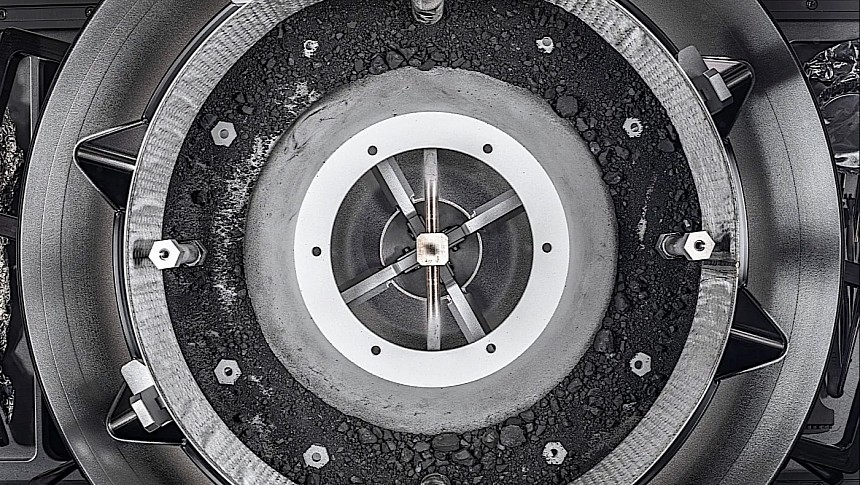Back in September 2023 a space capsule landed in the Utah desert. It brought with it samples of a distant asteroid, the first such mission ever conducted by the U.S. By now, almost five months later, we were kind of expecting all of those samples would be on their way to science labs across the world. But then "two stubborn fasteners" got in the way.
The capsule with the precious cargo was dropped to Earth last year by a spacecraft called Origins, Spectral Interpretation, Resource Identification, and Security–Regolith Explorer (OSIRIS-REx). It was the culmination of years of hard work and a long trip to an asteroid called Bennu, so teams were all over it as soon as the capsule arrived.
Less than a month after the touchdown, the capsule started revealing its contents. A total of 70 grams (2.12 ounces) of asteroid material were taken out, but more is still inside the capsule because of hardware issues.
To secure the contents during the trip, the people behind the mission designed special fasteners. A total of 35 of them kept the capsule sealed for the duration of the mission, and they were supposed to step aside once that was over. Two of the fasteners, it seems, had other ideas.
For one reason or another they refused to budge when NASA people used the approved and specially designed tools. After several ties the space agency had no choice but to start from scratch and design entirely new tools for the two fasteners.
The hardware not only had to be designed, but also tested before being used on the real thing, because the sensitivity of the material inside leaves very little room for error. And finally, the fasteners gave way.
The American space agency said these last hurdles were overcome earlier in January, and the OSIRIS-REx sampler head was finally disassembled, allowing access to the remainder of the asteroid sample.
Even if the main fight is over, further skirmishes will however continue. The metal collar on the hardware will have to be removed, and then the samples will have to be carefully removed. It might not seem like much, but like everything else in space exploration, it will take some time.
It's unclear how much asteroid material can still be found in there. As said, teams working on this have already collected a little over 70 grams of asteroid, significantly more than the set goal of bringing back 60 grams (2.1 ounces).
Now that it has access to all pieces of the samples, NASA said it will determine the total mass of alien soil brought back to Earth. By the end of spring 2024 we are also to get a catalog of all the Bennu samples.
NASA will not hold all of the samples for itself but plans to share them with the world. The catalog will help interested parties to submit requests for both research and display of the samples.
All the samples are stored at the Johnson Space Center in Houston, some of them at ambient temperature conditions, while others in deep freeze, at minus 112 degrees Fahrenheit (minus 80 degrees Celsius).
Less than a month after the touchdown, the capsule started revealing its contents. A total of 70 grams (2.12 ounces) of asteroid material were taken out, but more is still inside the capsule because of hardware issues.
To secure the contents during the trip, the people behind the mission designed special fasteners. A total of 35 of them kept the capsule sealed for the duration of the mission, and they were supposed to step aside once that was over. Two of the fasteners, it seems, had other ideas.
For one reason or another they refused to budge when NASA people used the approved and specially designed tools. After several ties the space agency had no choice but to start from scratch and design entirely new tools for the two fasteners.
The hardware not only had to be designed, but also tested before being used on the real thing, because the sensitivity of the material inside leaves very little room for error. And finally, the fasteners gave way.
The American space agency said these last hurdles were overcome earlier in January, and the OSIRIS-REx sampler head was finally disassembled, allowing access to the remainder of the asteroid sample.
Even if the main fight is over, further skirmishes will however continue. The metal collar on the hardware will have to be removed, and then the samples will have to be carefully removed. It might not seem like much, but like everything else in space exploration, it will take some time.
It's unclear how much asteroid material can still be found in there. As said, teams working on this have already collected a little over 70 grams of asteroid, significantly more than the set goal of bringing back 60 grams (2.1 ounces).
Now that it has access to all pieces of the samples, NASA said it will determine the total mass of alien soil brought back to Earth. By the end of spring 2024 we are also to get a catalog of all the Bennu samples.
NASA will not hold all of the samples for itself but plans to share them with the world. The catalog will help interested parties to submit requests for both research and display of the samples.
All the samples are stored at the Johnson Space Center in Houston, some of them at ambient temperature conditions, while others in deep freeze, at minus 112 degrees Fahrenheit (minus 80 degrees Celsius).







